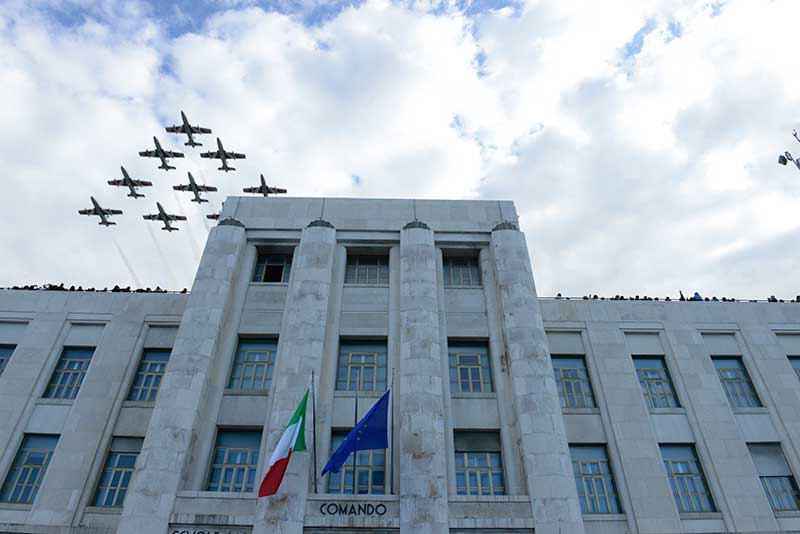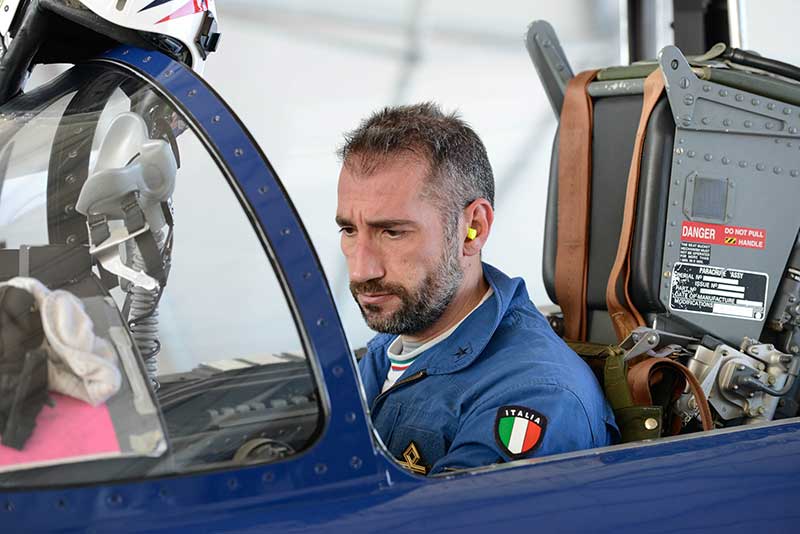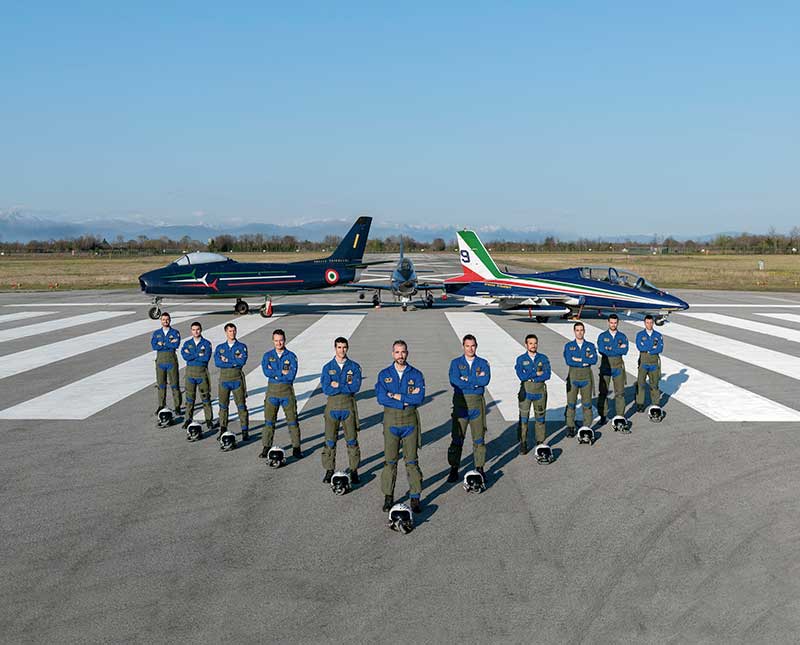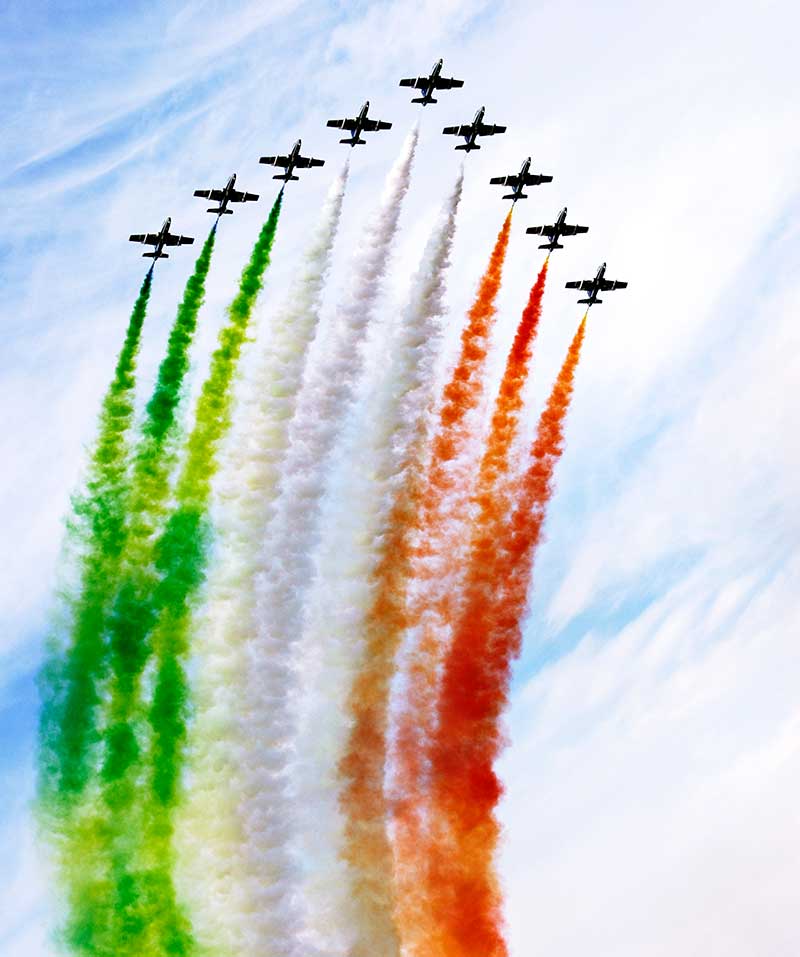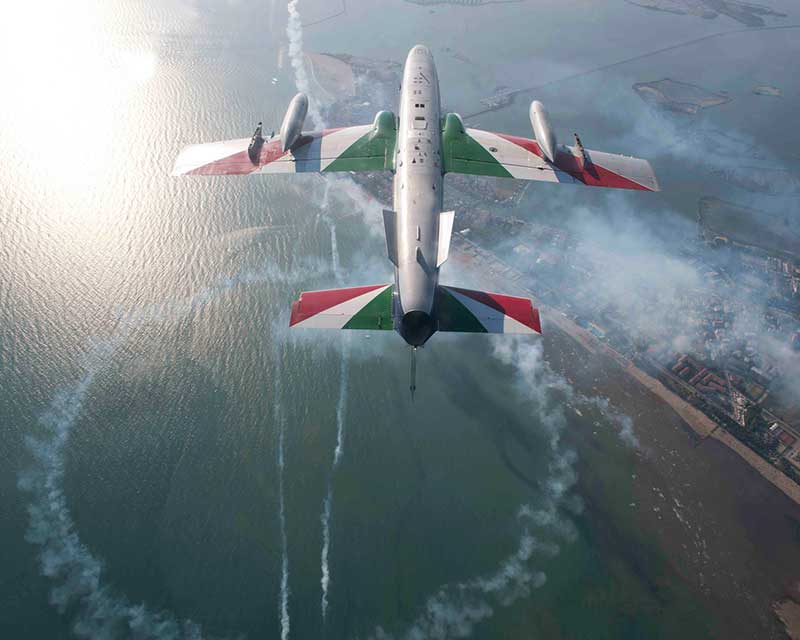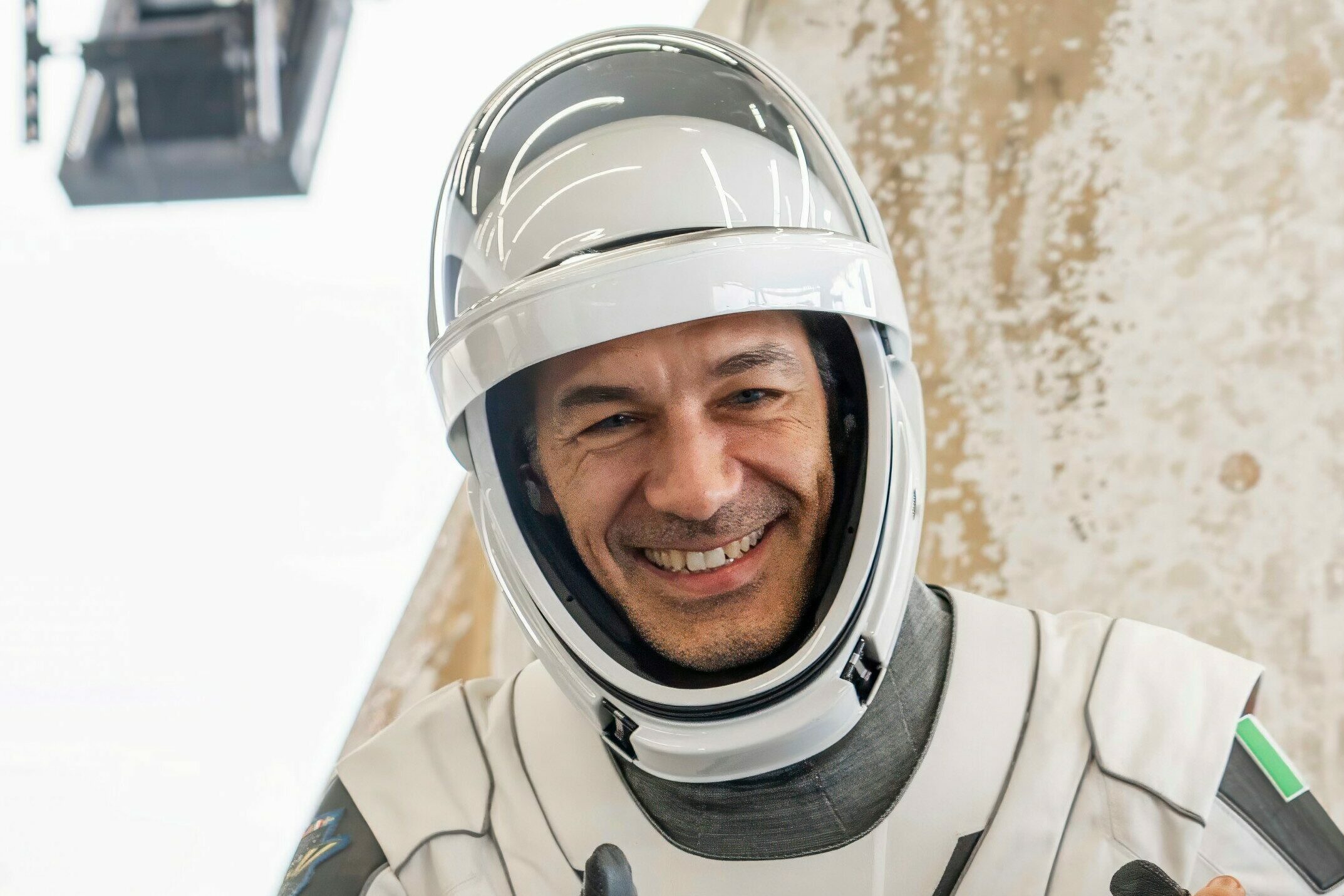Five biplanes dive down into their targets. The head of the group noses up and makes a full loop, while the others fringe off while turning upside down, only to dive down once more. Their trajectories criss cross those of other planes of the formation: it is the 8th of June 1930 and la bomba — the bomb, a figure bound to become legendary, is performed for the first time.
The Pattuglia Acrobatica Nazionale (PAN), was born in 1961, in Rivolto, at the very heart of Friuli Venezia Giulia and only a handful of miles from the Campoformido airport where, in 1928, the idea that acrobatic flight was to be part of military pilots’ training originated. Only through aerial acrobatics they could gain the mastery, sensibility and coordination needed in all flying situations.

In almost 60 years of existence, the Frecce Tricolori have been often called to highlight a number of significant moments in the history of our country @ Aeronautica Militare
The first six pilots assigned to the new unit showed a Cavallino Rampante (a prancing horse) on their planes, a symbol still there today, while they sketch with green, white and red smoke the Italian flag in the sky during fabulous, spine-tingling performances.
L’Italo-Americano interviewed Gaetano Farina, the 23rd Frecce Tricolori Commander. Born in 1979 in Puglia, more precisely in Francavilla Fontana (Brindisi), he studied at the Accademia Aeronautica di Pozzuoli and got a degree in Political and Aeronautical Sciences. He then attended the NATO School in Sheppard (Texas), where he obtained his military pilot license. F16 pilot in the 18mo Gruppo Volo del 37mo Stormo di Trapani, in 2010 he joined PAN where, in only 8 years, he became the head of Italian aviation’s most spectacular unit.

Gaetano Farina, commander of the Frecce Tricolori, at work on his craft @ Aeronautica Militare
Frecce Tricolori are a symbol of Italy. They are the 2nd of June, the 4th of November, the Altare della Patria and our Tricolore sketched high up in the sky. They are the Inno di Mameli and our most patriotic sentiments. You are not “only” extraordinary pilots…
In almost 60 years of existence, the Frecce Tricolori have been often called to highlight a number of significant moments in the history of our country, with their white red and green smoke. Probably, this tradition brought Italians to consider the National Acrobatic Patrol one of the symbols of our history. While this awareness carries with it the weight of responsibility for the role we are assigned, it also fills us with pride, as it gives us the opportunity to be custodians of a heritage that represents every Italian.

Frecce Tricolori’s team, led by Gaetano Farina (Centre) @ Aeronautica Militare
You are in charge of Italy’s most famous acrobatic unit. What does this mean to you and your peers, beside an enormous amount of training hours?
As a commander, I realize every day how lucky I am to be in charge of such an amazing group of men and women. Its strength, the thing that more than any other characterizes the Frecce Tricolori, lies in the way we work together: in team work. Everyone of us, while flying and while on the ground, offers his or her indispensable contribution to reach our objective.

Frecce Tricolori are a symbol of Italy
Your 2019 program counts 30 performances both in and outside of Italy. for an Italian living abroad, seeing the green-white-red smoke of the Frecce Tricolori is a bit like going back home, like flying with you to Italy.
Performing in front of our fellow Italians abroad is always special: the warmth and pride they manage to give us with their enthusiasm is vibrant, a feeling difficult to describe. Meeting them after flying is always exciting, an experience that has no equals because it manages to awaken that feeling of national pride that is within us all. And it does it every time. In that very moment, we are the link connecting these people with the country they love, even if far away. It’s an incredible feeling, that pays us back for every sacrifice we make to accomplish our mission.

The Pattuglia Acrobatica Nazionale (PAN), was born in 1961, in Rivolto, at the very heart of Friuli Venezia Giulia @ Aeronautica Militare
Part of your work is about training and education, which can also take place abroad. You, in particular, trained in the US. What kind of experience was it?
A military pilot’s education is a complex and very demanding path, that develops through a series of training steps, all important because they add something to the final result. In this sense, experiences abroad are an immense wealth because they allow you to come face to face with systems and professionals different from your own habitual reality. I remember my training in the US fondly: a time when I learned a lot from a professional point of view, but that helped me develop also personally, because I got to know a reality so different from what I was used to. It’s an experience that really gave me a lot.

Italy’s Frecce Tricolori during a performance @ Aeronautica Militare
PAN is team work, because you all work towards the same objective. How do you become part of the unit and what does being a team mean?
The Frecce Tricolori team sees pilots leaving and new ones arriving every year. We like to say that the interpreters change, but our amazing music score remains. Just like in an orchestra, the interaction among all elements determines the results more than single performances. For this reason, being an expert pilot is not enough to be part of PAN, you especially have to demonstrate to be a team worker. All pilots asking to be part of the unit are assessed to understand how well they would fit within the existing group: we’re talking about great professionals of our national Aviation, with no less that 750 hours of flight on high-performance aircrafts. This is our starting-point guarantee, which allows us to concentrate the selection process especially on each candidate’s attitude to be part of a team.
Acrobatic flight is characterized by technically complex figures, performed with apparent ease at an incredible speed. How do you create hearts, arrows, fans and sparkles? Who thinks of them and how do you get to actually perform them, as a group, with such precision?
The Frecce Tricolori’s flying program is the result of almost 60 years of history. During this period, a number of figures have been added, the last being the Scintilla Tricolore, the tricolored sparkle.These figures are first created and studied on the ground by the whole team and then tested in flight, starting with the figure’s key aircraft, then adding all the others. We continuously strive to reach precision, which is achieved thanks to daily training based on trust, an invisible connection among all the pilots of the unit.
What’s in your mind when you see those people down below, all staring up mesmerized by your performance?
While we fly, we are fully concentrated on our maneuvers, there is no space for emotions. Once we finish, however, we truly feel the warmth and enthusiasm of the public. Realizing we touched people’s heart makes us even prouder to represent the Aeronautica Militare and Italy.
Many children dream of becoming pilots. You realized this dream: what do you feel to say to these kids?
Never mind what dream you have, you should never allow anything or anyone to distract you from realizing it. Reaching your goals and making your dreams come true require constant commitment and sacrifice: there’ll be problems and difficulties, but you need to persevere and never give up. The results will be incredibly fulfilling.
Adults, who are probably more aware of what your work involves, look at your performances with equally enthusiastic and admiring eyes. What are, on the other hand, the emotions of those flying and why have you chosen PAN?
The idea itself of flying brings emotions in the heart of every man, because it brings us in a different dimension, one that is not natural to us, because we win over gravity. I think that acrobatic flying is yet another step on this road, because you can literally dance in the air. Professionally speaking, choosing to be part of the Frecce Tricolori was especially a challenge for me. I had the opportunity to test myself in a totally different context from the operative unit where I used to fly, I had to start anew, to challenge myself. Moreover, flying with PAN also means to have the honor to represent many fellow pilots, who every day serve our country and, more in general, to represent Italy as a whole.
What’s your relationship with fear and with the beauty of your job?
Fear is typical of human nature when we face something we don’t know. Training has exactly the aim of eliminating this factor, so we can be in charge and handle every situation. Once this facet of our job is under control, we can fully enjoy the beauty of flying and of the extraordinary emotions it can give.
Cinque biplani si gettano in picchiata sui bersagli. Il capo formazione cabra ed esegue un looping completo, mentre i gregari si sfilano, rovesciandosi, per gettarsi nuovamente in picchiata. Le loro traiettorie si incrociano con quelle degli altri velivoli della formazione. E’ l’8 giugno 1930. Per la prima volta viene eseguita la “bomba”, una figura destinata a entrare nel mito.
La Pattuglia Acrobatica Nazionale (PAN), nasce nel 1961 a Rivolto nel cuore del Friuli Venezia Giulia, a pochi chilometri dall’aeroporto di Campoformido dove nel 1928 era stata concepita l’idea che l’acrobazia dovesse diventare parte indispensabile dell’addestramento di un pilota militare perchè solo il volo acrobatico assicura padronanza, sensibilità e coordinazione in qualsiasi assetto di volo.
I primi sei piloti assegnati al nuovo reparto hanno sulla coda dei velivoli l’emblema del “Cavallino Rampante” che li accompagna ancora oggi, mentre in cielo disegnano con i fumogeni verdi, bianchi e rossi la bandiera italiana durante meravigliose esibizioni che, tra tonneau, scampanate e voli rovesciati, lasciano con il fiato sospeso.
L’Italo-Americano ha intervistato Gaetano Farina, 23° Comandante delle “Frecce Tricolori“.
Classe 1979, pugliese originario di Francavilla Fontana (Brindisi), Accademia Aeronautica di Pozzuoli, laurea in Scienze politiche e aeronautiche, Scuola Nato di Sheppard (Texas) dove consegue il brevetto di pilota militare, pilota di F16 nel 18° Gruppo Volo del 37° Stormo di Trapani. Nel 2010 entra nella PAN dove in soli otto anni, ottiene il comando della formazione più spettacolare dell’Aeronautica Italiana.
Le Frecce Tricolori sono un simbolo dell’Italia. Sono il 2 Giugno, il 4 Novembre, l’Altare della Patria, il Tricolore disegnato in cielo, l’Inno di Mameli, il sentimento patriottico. Non siete “solo” straordinari piloti.
Nei loro quasi 60 anni di vita, le Frecce Tricolori sono state spesso chiamate a sottolineare con i fumi verdi bianchi e rossi molti momenti significativi della storia del nostro Paese. Probabilmente questa tradizione ha influito nel far sì che gli italiani oggi considerino la Pattuglia Acrobatica Nazionale come uno dei simboli della nostra storia. Se da un lato questa consapevolezza porta con sé il peso della responsabilità per il ruolo che ci viene assegnato, dall’altro ci riempie d’orgoglio per l’opportunità di essere custodi di un patrimonio da cui ogni italiano può sentirsi rappresentato.
Ha il comando della pattuglia acrobatica più famosa d’Italia. Per lei e i suoi uomini cosa significa, oltre a migliaia di ore di addestramento?
Da Comandante mi rendo conto ogni giorno di quanto sia fortunato a poter guidare questo meraviglioso gruppo di uomini e donne. La sua grande forza, che più di ogni altra cosa contraddistingue le Frecce Tricolori, risiede senza dubbio nel lavoro di squadra: ognuno, in volo come a terra, sa fornire il proprio indispensabile contributo per il raggiungimento dell’obiettivo.
Il programma annuale 2019 conta 30 esibizioni dentro e fuori i confini nazionali. Per un italiano all’estero vedere quel fumo verde-bianco-rosso significa tornare a casa, volare con voi verso l’Italia.
Esibirci davanti ai nostri connazionali all’estero ha sempre un sapore particolare: il calore e l’orgoglio che sanno trasmettere con il loro entusiasmo è vibrante, una sensazione difficile da descrivere. Poterli incontrare dopo il volo è un’esperienza unica ed esaltante, capace di risvegliare ogni volta quel sentimento di fierezza nazionale che è insito in tutti noi; in quel momento siamo il punto di contatto tra quelle persone ed il Paese che amano anche se distanti: è una sensazione meravigliosa che ci ripaga di ogni sacrificio fatto per poter assicurare la nostra missione.
Una parte del vostro lavoro è la formazione, che in parte può essere all’estero. Lei in particolare è stato negli USA. Che esperienza è stata?
La formazione di un pilota militare è un percorso complesso e impegnativo, che si sviluppa attraverso diverse tappe addestrative, tutte importanti perché aggiungono qualcosa al bagaglio finale. In questo senso, le esperienze all’estero costituiscono un arricchimento enorme, perché consentono di confrontarsi con professionisti e sistemi diversi dalla nostra realtà abituale. Ricordo con particolare piacere il mio addestramento negli Stati Uniti, un periodo in cui ho imparato molto professionalmente e caratterialmente, proprio attraverso il contatto con una realtà distante da ciò a cui ero abituato: è un’esperienza che mi ha dato davvero molto.
La PAN è un lavoro di squadra, si lavora tutti per lo stesso obiettivo. Come si entra nella pattuglia e cosa significa essere team?
La formazione delle Frecce Tricolori registra ogni anno delle uscite di piloti e conseguenti ingressi di nuovi elementi: ci piace dire che nel tempo cambiamo gli interpreti di un unico meraviglioso spartito.
Come in un’orchestra, l’interazione tra tutti gli elementi determina il risultato molto più della performance del singolo individuo. Per questo motivo, per entrare nella Pattuglia Acrobatica Nazionale non basta essere esperti professionisti del volo, ma bisogna soprattutto dimostrare una grande inclinazione al lavoro di squadra.
Tutti i piloti che chiedono di entrare a far parte di questo gruppo vengono preventivamente sottoposti ad una selezione tesa a capire quale candidato possa meglio integrarsi con gli altri: parliamo di professionisti esperti, provenienti dalle linee jet dell’Aeronautica Militare e con alle spalle non meno di 750 ore di volo su velivoli ad alte prestazioni; questa garanzia di partenza ci permette di concentrare il processo di selezione soprattutto sull’attitudine ad essere parte di un team.
Il volo acrobatico prevede figure di estrema difficoltà tecnica eseguite con apparente disinvoltura a velocità impressionanti. Come ideate cuori, frecce, ventagli e scintille? Chi pensa a queste figure e come arrivate a saperle eseguire, in gruppo, con precisione millimetrica?
Il programma di volo è andato a comporsi nel corso di quasi 60 anni di storia; durante questo lungo periodo sono state aggiunte alcune figure, l’ultima è la “scintilla Tricolore”, che vengono dapprima studiate a terra, da tutto il team, e poi testate in volo, inizialmente utilizzando i velivoli cardine ed in seguito aggiungendo gli altri gregari sino a comporre la formazione completa.
Tutto il programma richiede una continua ricerca della precisione data dal quotidiano addestramento che si basa su uno stretto rapporto di fiducia, invisibile legame fra i piloti in formazione.
Quando vede sotto di lei tutte quelle persone con il naso all’insù che vi seguono rapiti durante le vostre spettacolari esibizioni, cosa pensa?
Durante il volo la concentrazione sulle manovre è al massimo, non c’è spazio per l’emozione. Ma una volta terminata la manifestazione riusciamo a percepire il calore e l’entusiasmo del pubblico: capire di essere riusciti a toccare i cuori delle persone ci fa sentire ancor più orgogliosi di rappresentare l’Aeronautica Militare e l’Italia.
Tanti bambini sognano di fare il pilota. Lei che questo sogno lo ha raggiunto cosa dice a quei bambini?
Indipendentemente da quello che sia il tuo sogno non bisogna permettere mai a niente o a nessuno di distogliere i tuoi sforzi dal suo raggiungimento. Riuscire a raggiungere i propri obiettivi e realizzare i propri sogni sicuramente richiede costante impegno e sacrificio: non mancheranno battute d’arresto e momenti difficili, ma bisogna perseverare senza mai arrendersi e il risultato sarà di certo incredibilmente appagante.
Forse, più consapevoli di quel che comporta il vostro lavoro, gli adulti, guardano le vostre esibizioni pieni di entusiasmo e ammirazione come i bambini. Quali sono invece le emozioni di chi vola e perché ha scelto la Pan?
L’idea stessa di volare emoziona ogni uomo, perché lo catapulta in una dimensione che non è la sua naturale, riuscendo ad avere la meglio sulla forza di gravità. Penso che il volo acrobatico sia un ulteriore passo avanti su questa strada, perché si può letteralmente danzare nell’aria. Sul piano professionale, la scelta di entrare a far parte delle Frecce Tricolori ha rappresentato per me soprattutto una sfida: ho avuto l’opportunità di mettermi alla prova in un settore completamente diverso rispetto al reparto operativo dove ricominciare praticamente da zero e mettermi in discussione. Non solo, volare con la PAN vuol dire anche avere l’onore di rappresentare, con il proprio operato, tanti colleghi che lavorano ogni giorno al servizio del Paese e, più in generale, di poter contribuire all’immagine dell’Italia intera.
Che rapporto ha con la paura e con la bellezza del suo lavoro?
La paura è un elemento tipico della natura umana che si presenta laddove siamo chiamati ad affrontare ciò che non conosciamo.
L’addestramento, tramite un processo continuo, ha esattamente lo scopo di eliminare questa componente consentendoci di esplorare tutte le possibilità ed essere padroni della situazione in qualsiasi circostanza. Gestito questo aspetto si può così godere appieno della meraviglia del volo e delle straordinarie emozioni che esso è in grado di regalare.
